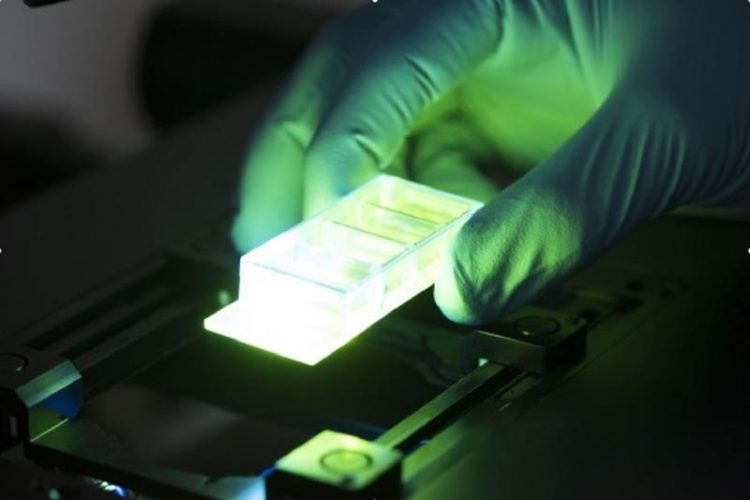Project BioSensing – detecting pathogens using quantum technology

In the future, DNA-stabilized metal quantum clusters could be used as highly sensitive, cost-effective biosensors due to their fluorescence properties © Fraunhofer ISC
Medical diagnoses could be even more reliable and efficient with the use of biosensors, but researchers face great challenges. The sensors should be sufficiently sensitive to detect even the smallest amounts of pathogens in the blood or other biological fluids.
At the same time, they should be able to identify even difficult-to-diagnose diseases in real time so that effective therapy procedures can start at an early stage.
These tasks are to be mastered with novel biosensors based on quantum effects in the project “BioSensing”, funded within the framework of the Fraunhofer program “ICON”. The project focuses on a novel class of biological nanomaterials, so-called DNA-stabilized metal quantum clusters (QC-DNA), which are used as “quantum biosensors”.
In their simplest form, these biosensors consist of a short DNA sequence that encloses a group of six to fifteen metal atoms called metal cluster. The choice of DNA sequence determines the sensor characteristics and which disease is detected. The basic structure of a quantum biosensor can be extended by additional specific biomolecules and thus be used for the detection of selected biomarkers.
But how do researchers recognize that a quantum biosensor has detected a specific disease? They use the fluorescence properties of the metal cluster. If a successful detection has taken place, the wavelength of the light emitted by the metal clusters changes.
QC-DNA are suitable for the development of highly sensitive sensors in biological systems and provide solutions for an advanced, intelligent and affordable therapy.
But such a quantum biosensor not only responds to diseases (caused by germs or even mutations in the genome), but also to changing environmental conditions, such as an increase of salt concentrations.
Further applications are possible such as the monitoring of food and forage or the use in environmental analysis. A significant advantage is the cost-effective production of quantum biosensors.
So far, tests were limited to the lab, but the project partners of Fraunhofer ISC, IME and Leiden University in the Netherlands have set themselves the goal of designing various quantum biosensors, scaling them up to pilot scale and preparing them for feasibility studies in university hospitals.
In follow-up projects, the partners plan to develop a portable read-out device that works cost-effectively, highly sensitively, quickly and reliably and detects various pathogens, toxins or cancer cells.
More Information
The Fraunhofer program “ICON – International Cooperation and Networking” supports bilateral research cooperation with international centers of excellence, for example universities, and creates opportunities to transfer basic research results into practice.
For the project “BioSensing” a cooperation with the Leiden University, Institute of Physics was established. Prof. Dr. Dirk Bouwmeester is one of the world's recognized researchers in the field of quantum physics. His research focus is on quantum optics and quantum information with a strong interest in DNA-stabilized metal quantum clusters. His fundamentally oriented research of QC DNA properties will yield completely new insights into the quantum physical relationships of these materials, necessary for the development of highly efficient biosensors.
The Fraunhofer ISC will use its many years of experience in the chemical synthesis and characterization of materials as well as in the development of biomaterials for the design and manufacture of quantum biosensors. For this purpose, Prof. Dr. Doris Heinrich and her 3D NanoCell Group study the dependence of the quantum biosensor synthesis on the starting materials and the synthesis process conditions. In addition, they develop microfluidic lab-on-chip systems for diagnostics.
The Fraunhofer IME with the working group of Dr. Greta Nölke has many years of experience in the field of recombinant protein and antibody technologies, the functionalization of biomolecules and the development of detection technologies and assays for the detection of pathogens and toxins. Further work includes cell based assays for high throughput microscopy on biological markers and for the evaluation of toxicity of e.g. nanomaterials.
http://www.isc.fraunhofer.de/en.html
http://www.3dnanocell.fraunhofer.de/en.html
http://www.ime.fraunhofer.de/en.html
http://www.universiteitleiden.nl/en/science/physics
Media Contact
All latest news from the category: Life Sciences and Chemistry
Articles and reports from the Life Sciences and chemistry area deal with applied and basic research into modern biology, chemistry and human medicine.
Valuable information can be found on a range of life sciences fields including bacteriology, biochemistry, bionics, bioinformatics, biophysics, biotechnology, genetics, geobotany, human biology, marine biology, microbiology, molecular biology, cellular biology, zoology, bioinorganic chemistry, microchemistry and environmental chemistry.
Newest articles

Silicon Carbide Innovation Alliance to drive industrial-scale semiconductor work
Known for its ability to withstand extreme environments and high voltages, silicon carbide (SiC) is a semiconducting material made up of silicon and carbon atoms arranged into crystals that is…

New SPECT/CT technique shows impressive biomarker identification
…offers increased access for prostate cancer patients. A novel SPECT/CT acquisition method can accurately detect radiopharmaceutical biodistribution in a convenient manner for prostate cancer patients, opening the door for more…

How 3D printers can give robots a soft touch
Soft skin coverings and touch sensors have emerged as a promising feature for robots that are both safer and more intuitive for human interaction, but they are expensive and difficult…





















